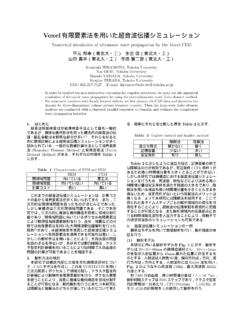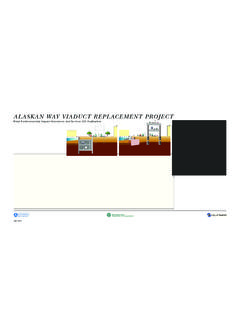Transcription of DUBAI METRO VIADUCT - JSCE 公益社団法人 土木学会
1 DUBAI METRO VIADUCT 1 DUBAI METRO VIADUCT The DUBAI METRO Project in United Arab Emirates is a full turn key project that includes the design and construction of the civil works and the rail system for two lines with a total extent of 75 km. It is the longest fully automated METRO network in the world. The project includes approximately km of viaducts between Rashidiya and Jebel Ali on the Red Line and km between Al Qusais and Jadaf on the Green Line. Most of the VIADUCT spans are simply supported bridges. Where longer spans are required, such as to cross highway interchanges or creeks, two span or three span continuous bridges are used. The VIADUCT superstructure consists of slender precast segmental post tensioned concrete troughs with a U shaped section. State of the art construction methods for segmented precasting, span by span construction and balanced cantilever construction were employed so as to complete the huge amount of work involved in the project within 56 months.
2 Further, the strategic requirement for durable, aesthetically pleasing and robust structures as well as environmentally friendly construction methods and a reliable rail system was successfully met. DUBAI METRO VIADUCT 2 The precast segments were fabricated at Jebel Ali, which is to the south of DUBAI . Casting for the decks was carried out in temporary yards of approximately 540,000 m2 in area. These precasting yards were designed to maximize the efficiency of precasting operations. The segments were produced by two different methods. One was a long line (on long beds) method and the other a short line method (on casting cells). Segments for straight spans, which were the majority in this project, were cast on long beds, which allow for a rapid precasting cycle, while pier segments for straight spans and all segments for curved spans were produced on casting cells, which allow for easier adjustment of the formwork to suit segment shapes as computed from the track alignment.
3 Two concrete batching plants were built in the yards in order to supply concrete specifically for this project. A key point was to obtain early age strength as quickly as possible so as to accelerate the precasting cycle. The overhead gantries used for the span by span construction method lifted delivered segments from the ground or from segment transporters on previously erected sections of the deck. The latter method was used where there was no suitable access for lifting the segments from the ground. By making provision for these two methods, the overhead gantries were able to erect most spans regardless of site conditions, leading to an effective and more rapid construction cycle. All segments for a complete span were suspended from the gantry while epoxy was applied to the joints and the temporary prestressing was installed in order.
4 Load transfer to temporary bearings took place while stressing the permanent tendons. This required two or three steps depending on the span length. DUBAI METRO VIADUCT 3 The span by span method was applied also for the viaducts forming the above ground stations. The special station viaducts support the platform screen doors, so they had to be designed with higher stiffness. A structure consisting of multiple continuous beams was selected for these station sections. Each span was erected by a launching gantry and placed on temporary bearings as a simple beam. After the gantry was removed, the spans were stitched by in situ concrete. The superstructure of the three span continuous bridges had to be stiffer than that of a simply supported beam. The designed superstructures accordingly consist of U shaped trough girders only near the end spans and a combination of U troughs and box girders near the centre piers.
5 This design enabled aesthetic continuity with adjacent spans, where the superstructure is U shaped trough girders, as well as ensuring the required stiffness where necessary. These bridges were constructed by the balanced cantilever technique, so that the flow of existing traffic could be maintained. DUBAI METRO VIADUCT 4 The pier caps take the form of a three dimensional curve, so it was not realistic to construct the more than 1,700 pier caps by a cast in situ method. Further, there was a need to shorten the construction period for the pier caps. After several feasibility studies, a half precast technique was selected to meet the requirements. Concrete shells were fabricated in a yard and transported to the site. The shells were then erected by cranes. After placement on the pier columns, the shell was filled with concrete and later prestressed.
6 A good connection between pier cap and pier was ensured by the bonding effect of starter bars protruding from the pier and the prestressing force in the pier cap. One of the challenging issues facing this project was achieving a 100 year design life for the concrete structures under the severe environmental conditions of the gulf region in the Middle East. A water proofing membrane and a protective coating were applied to the foundations and the above ground structures, respectively. These prevent aggressive substances in the ambient environment from entering the concrete. In addition, the concrete itself was designed to be highly durable, consisting of low w/c ratio OPC and a blended mix to achieve low permeability. Simultaneously, this mix results in a 50% reduction in CO2 emissions.
7















